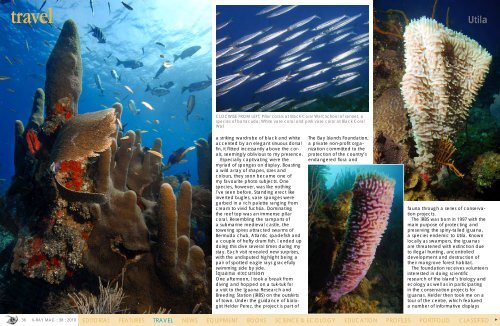Medium resolution version of X-Ray Magazine (96 dpi)
Medium resolution version of X-Ray Magazine (96 dpi)
Medium resolution version of X-Ray Magazine (96 dpi)
Create successful ePaper yourself
Turn your PDF publications into a flip-book with our unique Google optimized e-Paper software.
travel<br />
Utila<br />
CLOCWISE FROM LEFT: Pillar corals at Black Coral Wall; School <strong>of</strong> sennet, a<br />
species <strong>of</strong> barracuda; White vase coral and pink vase coral at Black Coral<br />
Wall<br />
a striking wardrobe <strong>of</strong> black and white<br />
accented by an elegant sinuous dorsal<br />
fin, it flitted incessantly above the corals,<br />
seemingly oblivious to my presence.<br />
Especially captivating were the<br />
myriad <strong>of</strong> sponges on display. Boasting<br />
a wild array <strong>of</strong> shapes, sizes and<br />
colours, they soon became one <strong>of</strong><br />
my favourite photo subjects. One<br />
species, however, was like nothing<br />
I’ve seen before. Standing erect like<br />
inverted bugles, vase sponges were<br />
garbed in a rich palette ranging from<br />
cream to vivid fuchsia. Dominating<br />
the reef top was an immense pillar<br />
coral. Resembling the ramparts <strong>of</strong><br />
a submarine medieval castle, the<br />
towering spires attracted swarms <strong>of</strong><br />
Bermuda chub, Atlantic spadefish and<br />
a couple <strong>of</strong> hefty drum fish. I ended up<br />
doing this dive several times during my<br />
stay. Each visit revealed new surprises,<br />
with the undisputed highlight being a<br />
pair <strong>of</strong> spotted eagle rays gracefully<br />
swimming side by side.<br />
Iquana excursion<br />
One afternoon, I took a break from<br />
diving and hopped on a tuk-tuk for<br />
a visit to the Iguana Research and<br />
Breeding Station (IRBS) on the outskirts<br />
<strong>of</strong> town. Under the guidance <strong>of</strong> biologist<br />
Helder Perez, the project is part <strong>of</strong><br />
The Bay Islands Foundation,<br />
a private non-pr<strong>of</strong>it organization<br />
committed to the<br />
protection <strong>of</strong> the country’s<br />
endangered flora and<br />
fauna through a series <strong>of</strong> conservation<br />
projects.<br />
The IRBS was born in 1997 with the<br />
main purpose <strong>of</strong> protecting and<br />
preserving the spiny-tailed iguana,<br />
a species endemic to Utila. Known<br />
locally as swampers, the iguanas<br />
are threatened with extinction due<br />
to illegal hunting, uncontrolled<br />
development and destruction <strong>of</strong><br />
their mangrove forest habitat.<br />
The foundation receives volunteers<br />
interested in doing scientific<br />
research <strong>of</strong> the island’s biology and<br />
ecology as well as in participating<br />
in the conservation projects for<br />
iguanas. Helder then took me on a<br />
tour <strong>of</strong> the centre, which featured<br />
a number <strong>of</strong> informative displays<br />
36 X-RAY MAG : 38 : 2010 EDITORIAL FEATURES TRAVEL NEWS EQUIPMENT BOOKS SCIENCE & ECOLOGY EDUCATION PROFILES PORTFOLIO CLASSIFIED
















